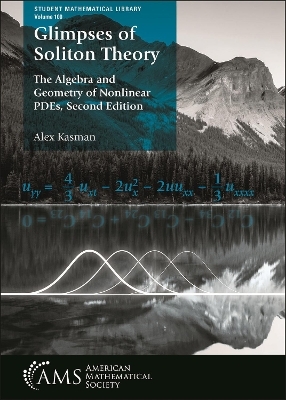
Glimpses of Soliton Theory
The Algebra and Geometry of Nonlinear PDEs
Seiten
2023
|
2nd Revised edition
American Mathematical Society (Verlag)
978-1-4704-7262-7 (ISBN)
American Mathematical Society (Verlag)
978-1-4704-7262-7 (ISBN)
Reveals the hidden connections discovered over the last half-century that explain the existence of these mysterious mathematical objects. The book aims to convince the reader that the underlying algebro-geometric structure of soliton equations provides an elegant explanation of something seemingly miraculous.
Solitons are nonlinear waves which behave like interacting particles. When first proposed in the 19th century, leading mathematical physicists denied that such a thing could exist. Now they are regularly observed in nature, shedding light on phenomena like rogue waves and DNA transcription. Solitons of light are even used by engineers for data transmission and optical switches. Furthermore, unlike most nonlinear partial differential equations, soliton equations have the remarkable property of being exactly solvable. Explicit solutions to those equations provide a rare window into what is possible in the realm of nonlinearity.
Glimpses of Soliton Theory reveals the hidden connections discovered over the last half-century that explain the existence of these mysterious mathematical objects. It aims to convince the reader that, like the mirrors and hidden pockets used by magicians, the underlying algebro-geometric structure of soliton equations provides an elegant explanation of something seemingly miraculous.
Assuming only multivariable calculus and linear algebra, the book introduces the reader to the KdV Equation and its multisoliton solutions, elliptic curves and Weierstrass $/wp$-functions, the algebra of differential operators, Lax Pairs and their use in discovering other soliton equations, wedge products and decomposability, the KP Hierarchy, and Sato's theory relating the Bilinear KP Equation to the geometry of Grassmannians.
Notable features of the book include: careful selection of topics and detailed explanations to make the subject accessible to undergraduates, numerous worked examples and thought-provoking exercises, footnotes and lists of suggested readings to guide the interested reader to more information, and use of MathematicaR to facilitate computation and animate solutions.
The second edition refines the exposition in every chapter, adds more homework exercises and projects, updates references, and includes new examples involving non-commutative integrable systems. Moreover, the chapter on KdV multisolitons has been greatly expanded with new theorems providing a thorough analysis of their behavior and decomposition.
Solitons are nonlinear waves which behave like interacting particles. When first proposed in the 19th century, leading mathematical physicists denied that such a thing could exist. Now they are regularly observed in nature, shedding light on phenomena like rogue waves and DNA transcription. Solitons of light are even used by engineers for data transmission and optical switches. Furthermore, unlike most nonlinear partial differential equations, soliton equations have the remarkable property of being exactly solvable. Explicit solutions to those equations provide a rare window into what is possible in the realm of nonlinearity.
Glimpses of Soliton Theory reveals the hidden connections discovered over the last half-century that explain the existence of these mysterious mathematical objects. It aims to convince the reader that, like the mirrors and hidden pockets used by magicians, the underlying algebro-geometric structure of soliton equations provides an elegant explanation of something seemingly miraculous.
Assuming only multivariable calculus and linear algebra, the book introduces the reader to the KdV Equation and its multisoliton solutions, elliptic curves and Weierstrass $/wp$-functions, the algebra of differential operators, Lax Pairs and their use in discovering other soliton equations, wedge products and decomposability, the KP Hierarchy, and Sato's theory relating the Bilinear KP Equation to the geometry of Grassmannians.
Notable features of the book include: careful selection of topics and detailed explanations to make the subject accessible to undergraduates, numerous worked examples and thought-provoking exercises, footnotes and lists of suggested readings to guide the interested reader to more information, and use of MathematicaR to facilitate computation and animate solutions.
The second edition refines the exposition in every chapter, adds more homework exercises and projects, updates references, and includes new examples involving non-commutative integrable systems. Moreover, the chapter on KdV multisolitons has been greatly expanded with new theorems providing a thorough analysis of their behavior and decomposition.
Alex Kasman, College of Charleston, SC.
Differential equations
Developing PDE intuition
The story of solitons
Elliptic curves and KdV traveling waves
KdV $n$-solitons and $/tau$-functions
Multiplying and factoring differential operators
Eigenfunctions and isospectrality
Lax form for KdV and other soliton equations
The KP equation and bilinear KP equation
$/Gamma_{2,4}$ and the bilinear KP equation
Pseudo-differential operators and the KP hierarchy
$/Gamma{k,n}$ and the bilinear KP hierarchy
Concluding remarks
Mathematica guide
Complex numbers
Ideas for independent projects
References
Glossary of symbols
Index
| Erscheinungsdatum | 10.07.2023 |
|---|---|
| Reihe/Serie | Student Mathematical Library |
| Verlagsort | Providence |
| Sprache | englisch |
| Maße | 140 x 216 mm |
| Gewicht | 226 g |
| Themenwelt | Mathematik / Informatik ► Mathematik ► Algebra |
| Mathematik / Informatik ► Mathematik ► Analysis | |
| ISBN-10 | 1-4704-7262-7 / 1470472627 |
| ISBN-13 | 978-1-4704-7262-7 / 9781470472627 |
| Zustand | Neuware |
| Informationen gemäß Produktsicherheitsverordnung (GPSR) | |
| Haben Sie eine Frage zum Produkt? |
Mehr entdecken
aus dem Bereich
aus dem Bereich
A Selection of Highlights
Buch | Softcover (2023)
De Gruyter (Verlag)
69,95 €


